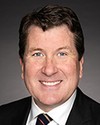Thank you.
I have just one last question. Do you think that the impact of doom-and-gloom projections, by perhaps the Conservatives, have an impact on how people invest in Canada and on our economic outlook over the next year or so?
Evidence of meeting #119 for Public Accounts in the 44th Parliament, 1st Session. (The original version is on Parliament’s site, as are the minutes.) The winning word was inflation.
A video is available from Parliament.
4:05 p.m.
Liberal

Iqra Khalid Liberal Mississauga—Erin Mills, ON
Thank you.
I have just one last question. Do you think that the impact of doom-and-gloom projections, by perhaps the Conservatives, have an impact on how people invest in Canada and on our economic outlook over the next year or so?
4:05 p.m.
Nicolas Moreau Associate Assistant Deputy Minister, Financial Sector Policy Branch, Department of Finance
One way to look at it is to go back to the credit ratings agencies. Since we published the budget, they have looked at our numbers, and one of the rating agencies, Moody's, reiterated our AAA rating. S&P and Fitch also came out with a report saying that the track that we have there of declining debt to GDP was a positive thing, moving forward.
Overall, I don't think the investment mood in Canada changed that much following the budget. That was because of the well-received comments that we got from the ratings agencies.
4:05 p.m.
Conservative

The Chair Conservative John Williamson
Thank you very much.
We now go to Mr. Lemire for six minutes.
May 7th, 2024 / 4:05 p.m.
Bloc

Sébastien Lemire Bloc Abitibi—Témiscamingue, QC
Thank you, Mr. Chair.
My first question is for the Bank of Canada officials.
The figures show that money supply growth was very high in 2020 and 2021. Would you say that has to do with the Bank of Canada's monetary policy or the government's expansionary fiscal policy?
4:05 p.m.
Senior Deputy Governor, Bank of Canada
I'm sorry, but can you repeat your question? I didn't hear the...
4:05 p.m.
Bloc

Sébastien Lemire Bloc Abitibi—Témiscamingue, QC
We see that money supply growth was very high in 2020 and 2021. Does that have to do with the Bank of Canada's monetary policy or the government's expansionary fiscal policy?
4:05 p.m.
Senior Deputy Governor, Bank of Canada
Thank you for your question. I'm going to answer in English, if you don't mind.
4:05 p.m.
Bloc
4:05 p.m.
Senior Deputy Governor, Bank of Canada
If I understand your question, you're asking whether the expansion.... It's similar to the previous question from Mr. Chambers. Is the monetary base or the different monetary aggregates that we would use a result of the monetary policy of the Bank of Canada? Do I understand your question correctly?
4:05 p.m.
Bloc

Sébastien Lemire Bloc Abitibi—Témiscamingue, QC
We always hear Pierre Poilievre blaming the government's expansionary fiscal policy for inflation being so high, but then he also blames the Bank of Canada.
Can you enlighten us? Between the two arguments, where does the reality lie?
4:05 p.m.
Senior Deputy Governor, Bank of Canada
There are different measures of money supply, what we call different monetary aggregates. There are printed banknotes and there are central bank reserves that are held by members of Payments Canada at the bank and there is the measure that Mr. Chambers asked me about, M2, which includes bank accounts that people like you and me have. The measure of money supply that went up as a direct result of our monetary policy was the central bank reserves. Those have expanded significantly as a result of our monetary policy. It's a direct result of the quantitative easing that the bank undertook.
4:05 p.m.
Bloc

Sébastien Lemire Bloc Abitibi—Témiscamingue, QC
Thank you. It's helpful to hear that answer outside the political context. I was being non-partisan when I asked the question.
Inflation hit 5.1% in January 2022. The Bank of Canada did not start raising its key policy rate until March 2022, when inflation was at 6.7%.
Why did you wait so long to raise the rate if the bank's main objective is to keep inflation at 2%?
4:05 p.m.
Senior Deputy Governor, Bank of Canada
Again, I'm just going to repeat your question to make sure I understand it, sir. Were you asking about the pace of the increase in inflation relative to the pace of the increase in our policy rate, and asking why we waited? That is fundamentally what you asked. Is that correct?
4:05 p.m.
Bloc

Sébastien Lemire Bloc Abitibi—Témiscamingue, QC
If your target is 2%, why did you wait so long? You waited until inflation was up to 6.7% before you started raising the rate.
4:05 p.m.
Senior Deputy Governor, Bank of Canada
Yes, I understand.
I think initially there was a lot going on in the economy at the time, a lot of very unique circumstances. It was very difficult for us to really forecast and even understand in detail what was going on in the economy at the time. The models that we typically use to forecast inflation don't account for completely shutting down our economy for months on end and then restarting it.
I think initially the central banks around the world, including the Bank of Canada, understood that the drivers of inflation were largely what we would characterize as supply-driven. There was a lack of supply in the economy. Supply chains were recovering from being shut down, and there were some global forces that were also affecting inflation at the time. The invasion of Ukraine was causing a spike in commodity prices.
Typically, those are things that central banks “look through”. We wouldn't necessarily react immediately to things like that, because you could raise rates and slow the economy, and typically things like supply shocks or commodity shocks recover quickly, and then you may have slowed your economy needlessly when these supply shocks recover.
I think initially the Bank of Canada, and central banks around the world, were viewing what was happening in the economy, and as the member said earlier, this was happening globally, not just in Canada. Those shocks persisted longer than we anticipated, and at the same time, the demand in the economy came back quite aggressively as we had that reopening, so it was a combination of those two things.
I would agree. I think the governor has said publicly, and most governors have said publicly, that in hindsight on whether we waited longer than we should have, perhaps we did. Those supply shocks took longer to repair than we anticipated, and demand surged back more quickly than we anticipated.
4:10 p.m.
Bloc

Sébastien Lemire Bloc Abitibi—Témiscamingue, QC
I have a question about your decision-making process.
It is often said that the Bank of Canada is independent. Can you explain how you make decisions about the key policy rate? Who do you consult?
4:10 p.m.
Senior Deputy Governor, Bank of Canada
The bank has an ongoing consultation process. It isn't necessarily at each rate decision. We regularly meet with Canadians, with Canadian businesses, with organizations, industry associations and stuff. We are regularly talking to Canadians about conditions in the economy. At each rate decision, we go through quite a.... It might sound like we get in a room on the morning of the rate decision and make a decision, but it's actually quite a long decision-making process that starts with a projection that our staff presents to us. We go through a series of analyses and we run some scenarios and that type of thing. Each decision-making process is quite structured, quite lengthy, very deeply analytical.
As to your specific question about whom we consult, the bank has a robust ongoing consultation process that helps us stay in touch with the economy.
4:10 p.m.
Conservative

The Chair Conservative John Williamson
Thank you, Mr. Lemire. You're out of time, but I did give you extra time because of the interpretation issues.
Mr. Desjarlais, you have the floor for six minutes, please.
4:10 p.m.
NDP

Blake Desjarlais NDP Edmonton Griesbach, AB
Thank you very much, Mr. Chair. I want to thank all the witnesses for being present today.
I'll start my questions with the Bank of Canada.
As noted, there were significant losses from 2020 to 2023. Your policies largely account for some of those challenges. Of course, there was a global pandemic. You just mentioned some of the decision-making processes around how your analysis for supply feeds into the policies you make, but in between that time, in addition to what you've already said, what is the total amount of losses, including the indemnities paid by the Government of Canada?
4:10 p.m.
Senior Deputy Governor, Bank of Canada
Again, I'll just clarify your question. Are you asking for the total losses to date?
4:10 p.m.
NDP

Blake Desjarlais NDP Edmonton Griesbach, AB
Sorry. I mean between 2020 and 2023. In addition to your former answer on supply, what other factors led to these losses?
4:10 p.m.
Senior Deputy Governor, Bank of Canada
Okay. Coralia, do you want to go ahead with the total losses from 2020 to 2023?
4:10 p.m.
Managing Director and Chief Financial Officer, Bank of Canada
The public accounts for 2021-22 show that we had a surplus. The first year with a loss was 2022-23, at $3.1 billion.
4:15 p.m.
NDP

Blake Desjarlais NDP Edmonton Griesbach, AB
In terms of the responses.... I'm sorry. Was that just the 2021 year?
4:15 p.m.
Managing Director and Chief Financial Officer, Bank of Canada
In the 2021-22 year, we had a surplus of $2.3 billion. The 2022-23 year is the first year public accounts showed a loss. It was $3.1 billion.